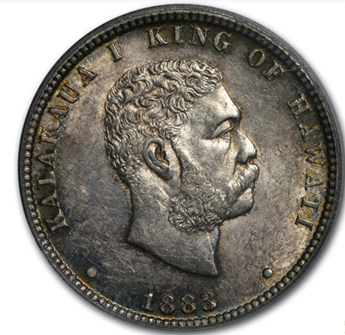
The Story of Hawaiian Coins
Before the Hawaiian Islands were settled by Europeans, there were many indigenous peoples there. While they didn’t have coinage, they did use Cowry shells, beads, feathers, sandalwood, and some exotic spices as mediums of exchange.
As British naval officers and enlisted men went to Hawaii with Captain Cook and settled there, they brought British and European coinage with them and used their coinage, in the absence of a more formal system.
King Hamehameha III wanted to establish a truly Hawaiian coinage without using coins from other countries. His grandfather, King Kamehameha I, believed that Gold and Silver metals had value that was easily standardized when they were struck as coins. In 1847, he established a coin that was very similar in size and weight to the then-circulating Large Cent coins of the United States. In fact, due to the proximity of the United States and the fact that it was a democracy, King Kamehameha III tried to mimic their coinage. Called the KENETA, this one cent Hawaiian coin would be minted in a large enough quantity to be used all over the islands and once it was accepted everywhere other, larger denominations would be added.
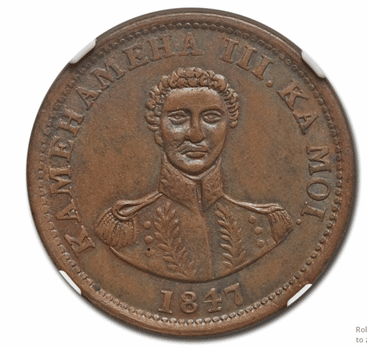
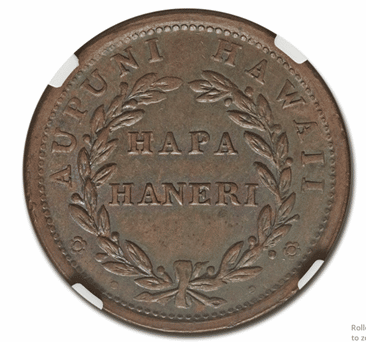
The obverse of this coin displays a military bust of the king on the obverse, facing forward, with the legend “KAMEHAMEHA III. KA MOI.” around him and the date “1847” below.
The reverse has the denomination “HAPA HANERI” within a wreath, tied with a bow at bottom, surrounded by “AUPUNI HAWAII.” There are two different obverse varieties – one with a Plain 4 in the date, and the other has a Crosslet 4. There are also six separate varieties of reverse dies.
After being struck, the coins left the port of Boston and sailed south down the eastern coast of America, south past Central America and along the east coast of South America. The ship then sailed south coming around the tip of South America at Tierra del Fuego. Now the ship headed north along the coast of South America and then headed due west across the Pacific to Tahiti.
That was the last stop before docking in Honolulu. However, after five months on board the humid and wet ship, many of the copper coins were badly discolored. But even worse, the King’s portrait was unrecognizable to his subjects. It took a number of years before even a small number of the 100,000 coins were disbursed. Today the coins are considered scarce and are valuable.
King Kalakaua truly wanted the Kingdom to have its own coinage. The King turned to a trusted friend of his, Claus Spreckels, to negotiate and mediate negotiation between the Kingdom and the United States Mint. The 1880 Hawaiian Coinage Law provided for a One Dollar, a Fifty cent, a Twenty Five cent, and a Twelve-and-One-Half cent coins. However, to be compatible with US coinage the Twelve-and-One-Half cent coin was changed to a Ten cent coin.
The Director of the US Mint, Horatio Burchard, advised him that the US Mint would strike coinage for Hawaii, but the dies would need to be engraved in Philadelphia and sent to San Francisco for minting. Charles E. Barber, the Chief Engraver of the US Mint, would create the dies once he had appropriate sketches of the King. After approval, Barber sent dies to San Francisco for striking.
The One Dollar coin depicted a bust of King Kalakaua facing right. Above him are his name and “KING OF HAWAII”. The date, “1883”, which is below his bust is offset with two periods, one on either side of the date.
The reverse displays the shield of the Royal Arms, emblazoned on a mantle, on the Dollar coin. Above the shield is the Royal Crown as well as the Star of Kamehameha, suspended below the shield. Surmounting the shield is the motto of Hawaii and the denomination in English “1 D” is below the motto and the denomination in Hawaiian is provided at the bottom of the coin – “AKAHI DALA.” The complete mintage of Silver Dollars, 500,000 coins were struck at San Francisco.
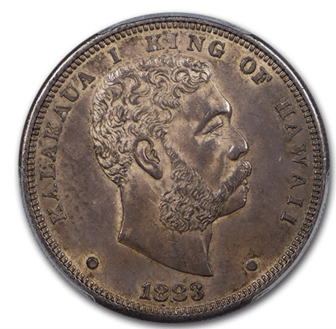
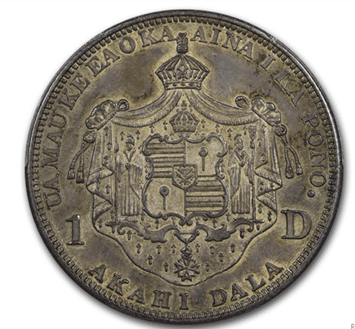
Next was the 1883 Hawaiian Fifty cent piece, of which 700,000 were struck and shipped to the Kingdom. The obverse design was the same, with the size was reduced. The reverse was changed to simply display the Royal Arms with the Crown above it. These elements are not displayed on the previous mantle nor is the Star of Kamehameha shown at all. The denomination is displayed as “1/2 D” in English and also in Hawaiian as “HAPALUA”.
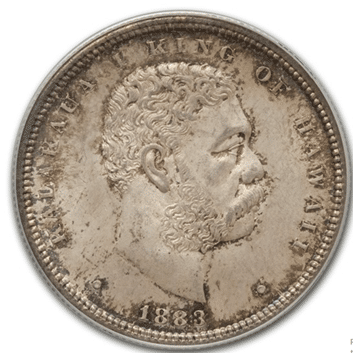

The San Francisco Mint struck 500,000 Hawaiian Quarter Dollars and the design exactly matched that of the Half Dollar, except in size and in the denomination expressed on the reverse as “1/4 D” in English and as “HAPAHA” in Hawaiian.

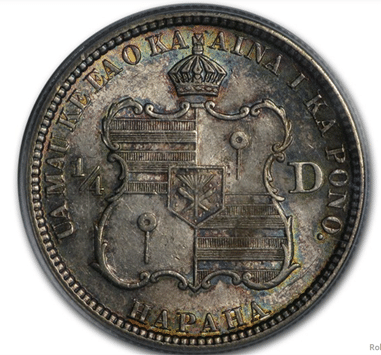
The Hawaiian Ten Cent coin, like all of the others , was struck by the San Francisco Mint. There were 250,000 coins struck. It bore a very close resemblance to the Barber Dime of that day with the denomination “ONE DIME” inside of the wreath and the Hawaiian version “UMI KENETA” at the bottom.
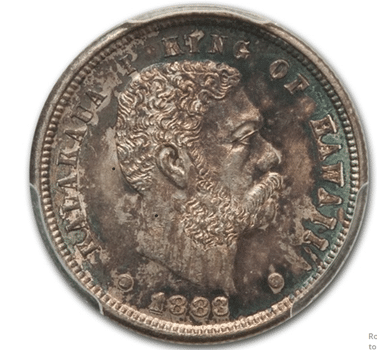
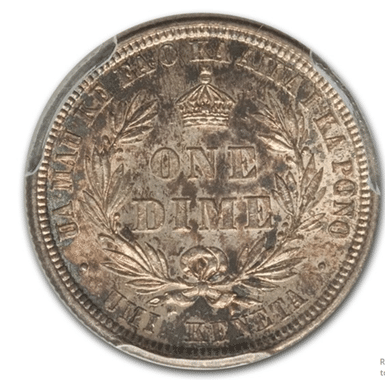
By the 1890s, the Hawaiian population was displeased with the monarchy, and it fell. The Islands declared their autonomy as a Republic on July 4, 1894. Yet during that period the coinage, even while bearing portraits of prior monarchs, remained the symbol of stability. But by 1898, the Republic of Hawaii was annexed by the United States as an Official Territory.
In 1903, the US Congress decreed that as of January 1, 1904, all Hawaiian silver coinage had to be exchanged for US coinage. When that was completed, nearly $814,000 of the original $1,000,000 face value of Hawaiian coinage had been returned to the United States Mint in San Francisco and melted and remanufactured into US coins.
Less than $190,000 worth of face value Hawaiian coinage remained in existence and some of it was “lost” during World War II, when the invasion of Hawaii by Japan was a real possibility.
| Denominations | Circulated Mintages | Proof Mintages | Officially Melted | Distributed |
| One Cent | 100,000 | 0 | 88,405 | 11,595 |
| Dime | 250,000 | 26 | 79 | 249,947 |
| Twelve & One Half Cents | 0 | 20 | 0 | 20 |
| Quarter Dollar | 500,000 | 26 | 257,400 | 243,626 |
| Half Dollar | 700,000 | 26 | 612,245 | 87,781 |
| Dollar | 500,000 | 26 | 453,652 | 46,374 |
We cannot discuss Hawaiian coinage without mentioning the Plantation tokens that circulated in the islands well before Hawaii created its own coinage.
Hawaii’s main crop has always been sugar cane and the Islands’ main export caused very large plantations to be created on virtually all of the islands. When coinage is not available, the plantations, themselves, will create their own money that can be used as cash in the company stores on the plantations. Many of these Hawaiian tokens are well-known and widely collected today.
A number of the other plantation tokens are not sophisticated in their design but were the popular coins for those working on these plantations. A very popular denomination for a number of these plantation tokens is Twelve and a Half Cents, as that is what many workers were paid for a full twelve hours of back-breaking daily labor.
The Wailuku Plantation is the most well-known of all plantation tokens. They issued two simple but effective tokens in both 12.5 cents and 6.25 cents denominations for full day and half day labors. They also issued tokens One Half Real and One Real.
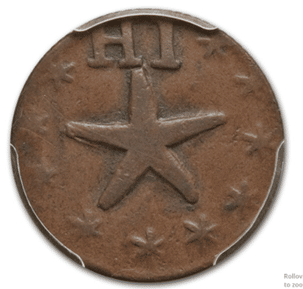
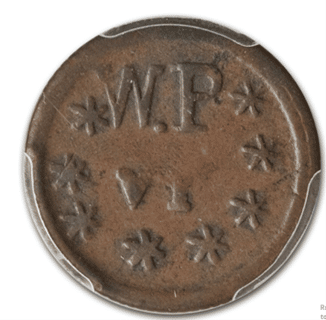
Hawaiian coinage and tokens are highly collectible and interesting mementos of America’s colonial past.





